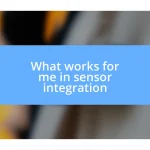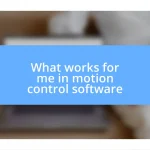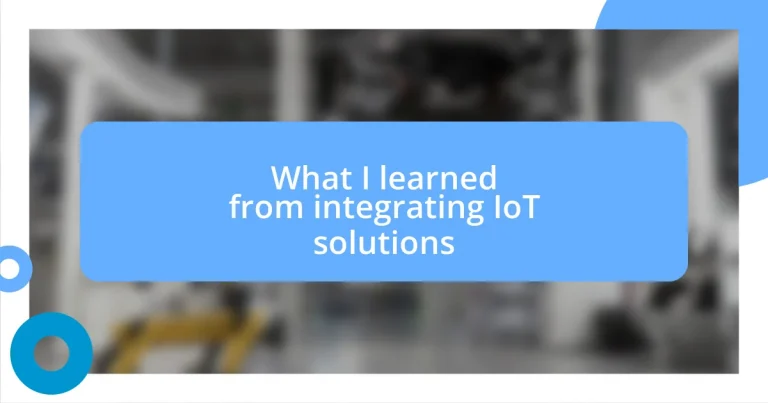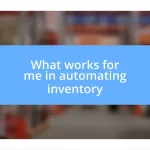Key takeaways:
- Integrating IoT solutions enhances operational efficiency and enables data-driven decision-making, transforming data into actionable insights.
- Key challenges in IoT integration include data security risks, interoperability issues, scalability concerns, and the high cost of implementation, requiring proactive strategies.
- Successful IoT integration hinges on a clear needs assessment, collaboration among diverse teams, and continuous monitoring, with an emphasis on security and user-friendly tools.
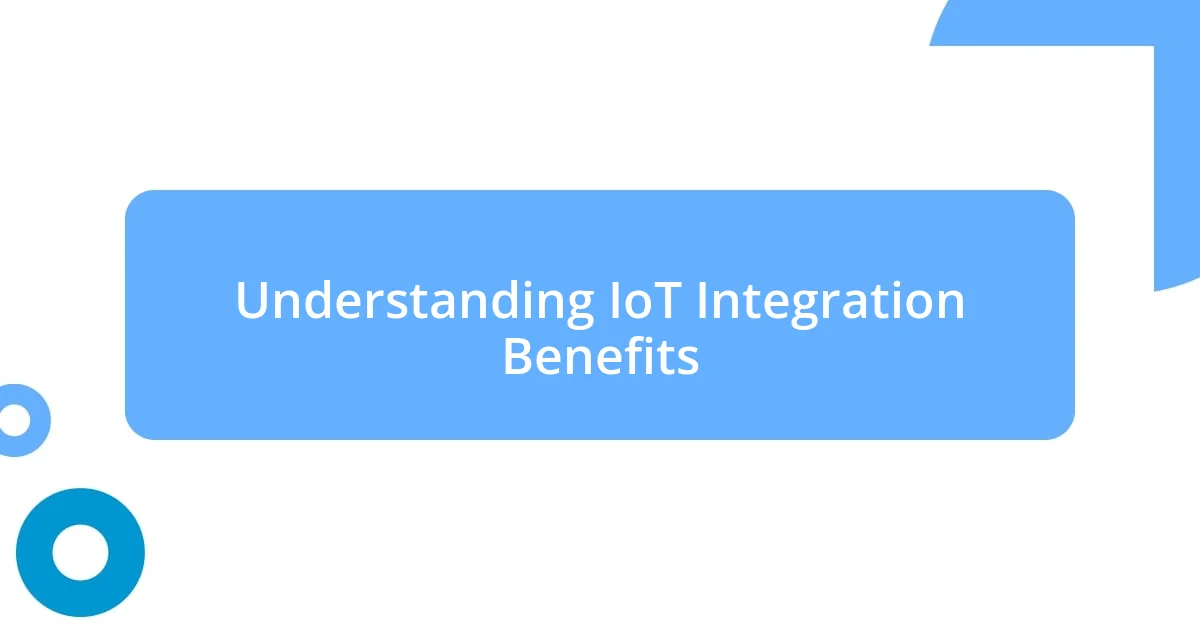
Understanding IoT Integration Benefits
Integrating IoT solutions has opened my eyes to the sheer efficiency they bring to operations. I still remember the first time I connected sensors to monitor energy usage in my workspace; the immediate feedback was almost like a light bulb moment. It made me wonder—how much more could businesses save if they used similar solutions?
One benefit that often goes unnoticed is data-driven decision-making. With IoT devices continuously collecting data, I can analyze trends that help refine processes. For example, implementing smart inventory systems led to a surprising reduction in waste—something I thought wouldn’t be manageable. Isn’t it fascinating how technology can transform what seems mundane into actionable insights?
Furthermore, IoT integration enhances customer experiences in ways I’d never imagined. I once deployed a smart HVAC system that adjusted temperatures based on the occupancy of a space. The positive feedback from users made me realize that technology isn’t just about efficiency; it’s also about creating a more comfortable and responsive environment. Isn’t that what we all seek in today’s fast-paced world?
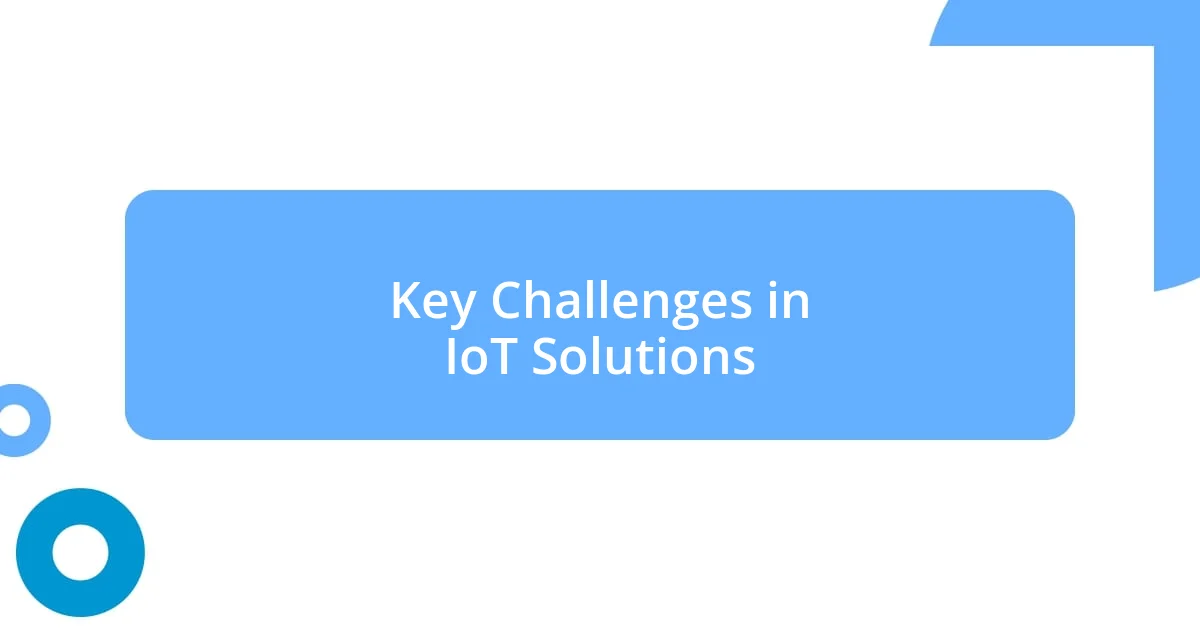
Key Challenges in IoT Solutions
When diving into the world of IoT, I quickly encountered several challenges that were both eye-opening and pivotal to my journey. One major hurdle was data security; the more devices I connected, the more vulnerable my network seemed. I recall my unease when a colleague shared a story about a smart door lock that was hacked, reminding me that every innovation carries risks.
Here are some key challenges I faced in IoT integration:
- Data Security Risks: Protecting sensitive information from cyber threats is crucial.
- Interoperability Issues: Ensuring that devices from different manufacturers communicate seamlessly can be tricky.
- Scalability Concerns: As the number of devices grows, managing and maintaining them becomes increasingly complex.
- Cost of Implementation: The initial investment needed for IoT solutions can sometimes be daunting.
Navigating these challenges has forced me to become more proactive in seeking solutions. I remember a late night spent researching cybersecurity protocols, which was exhausting but ultimately rewarding. Establishing proper safeguards instantly shifted my perspective; I began to view security not just as a hindrance, but as a vital component that empowers innovation.
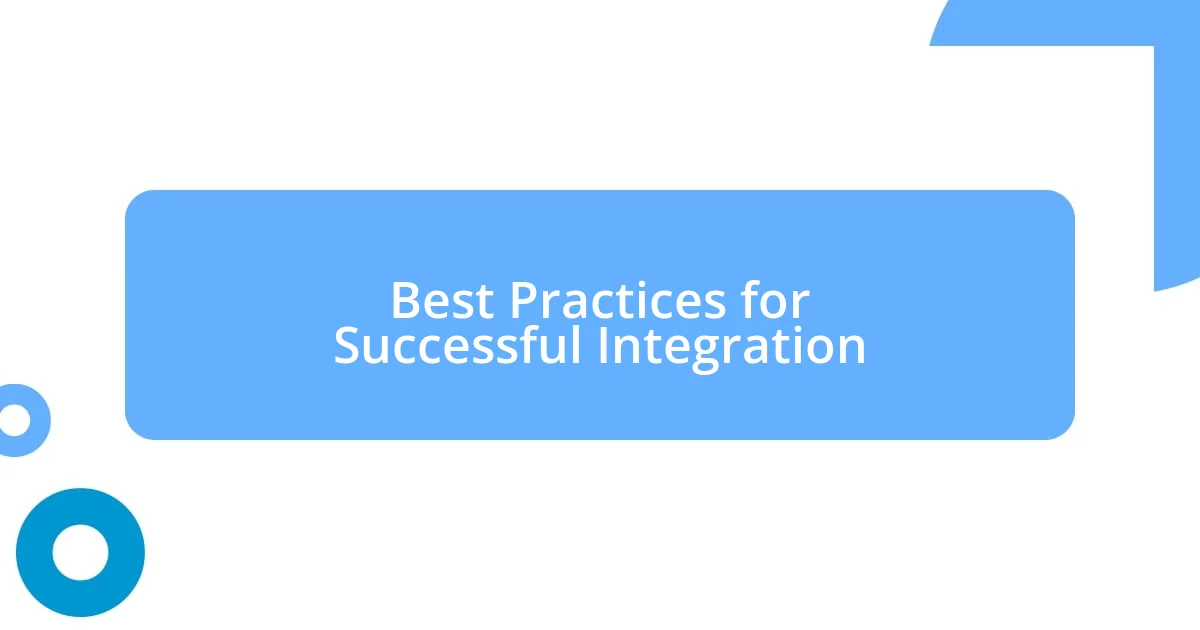
Best Practices for Successful Integration
It’s essential to have a clear strategy before diving into IoT integration. In my experience, conducting a needs assessment was invaluable. I took the time to understand our specific requirements, which ultimately saved us from investing in unnecessary technology. This approach not only made the integration smoother but also ensured that every device we utilized served a clear purpose.
Collaboration is another cornerstone of successful IoT integration. I learned this firsthand when I brought together our IT team and operations staff to brainstorm the integration process. This teamwork resulted in innovative solutions that I hadn’t initially considered. By embracing diverse perspectives, we developed a holistic approach that addressed both technical and practical challenges effectively.
Lastly, continuous monitoring and feedback loops are crucial. Regularly assessing how the IoT systems perform can lead to significant improvements over time. I vividly recall a situation where tracking device performance revealed unexpected downtime patterns. Addressing those issues equipped us with better insights, showcasing how adaptability can turn initial hurdles into growth opportunities.
| Best Practice | Description |
|---|---|
| Needs Assessment | Clearly identifying requirements to avoid unnecessary technology investments. |
| Collaboration | Bringing together diverse teams to brainstorm and innovate solutions. |
| Continuous Monitoring | Regular assessment of device performance to adapt and improve over time. |
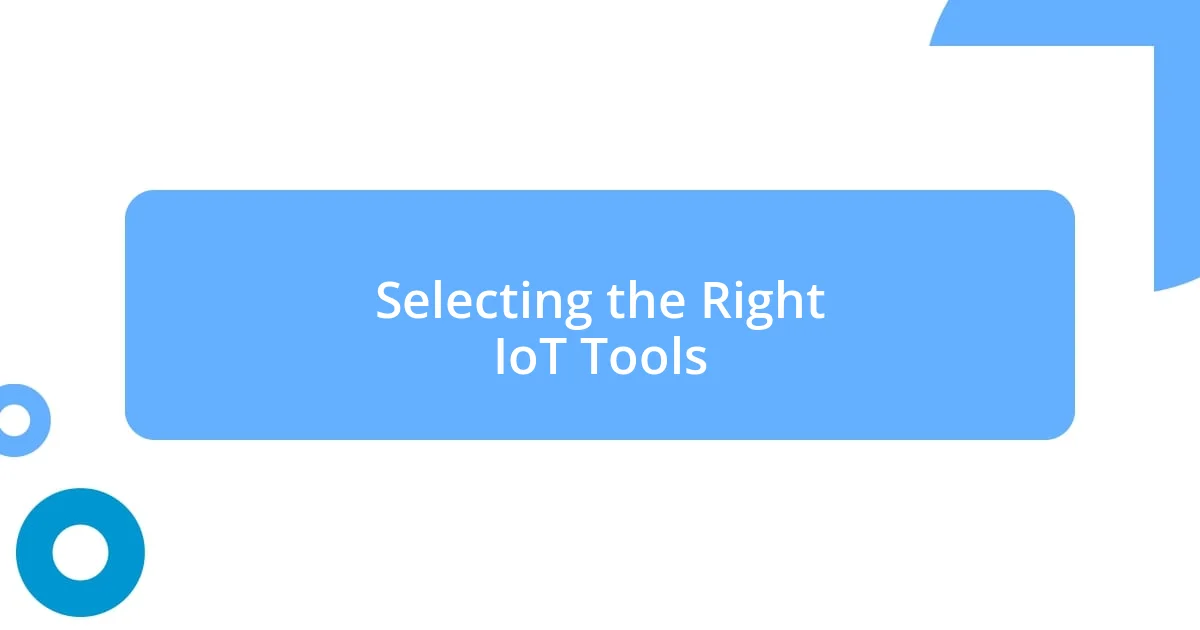
Selecting the Right IoT Tools
Selecting the right IoT tools can feel overwhelming given the myriad of options available. In my early days of integrating IoT solutions, I recalled getting lost in a sea of flashy devices and solutions that promised the world. It was through a thoughtful evaluation of our specific business needs that I learned to narrow down my choices effectively. Are you assessing your requirements up front, or are you letting marketing buzz influence your decisions?
One pivotal moment for me was when I decided to prioritize interoperability. Initially, I overlooked this aspect, thinking any device could fit into our existing ecosystem. I quickly learned the hard way when two devices I purchased couldn’t communicate, leading to frustration and wasted resources. This experience taught me that selecting tools that can seamlessly integrate with one another not only saves time but also enhances operational efficiency.
I also found that user-friendliness should never be underestimated. Initially, I was enticed by sophisticated features but soon realized that some of the best tools are those that make it easy for teams to embrace them. I remember the relief on my colleagues’ faces when we adopted a straightforward dashboard for monitoring our IoT devices. The simplicity boosted our engagement and paved the way for quicker decision-making, proving that the best technology is often the one that your team can actually use. Are your chosen tools empowering your team, or are they creating barriers?
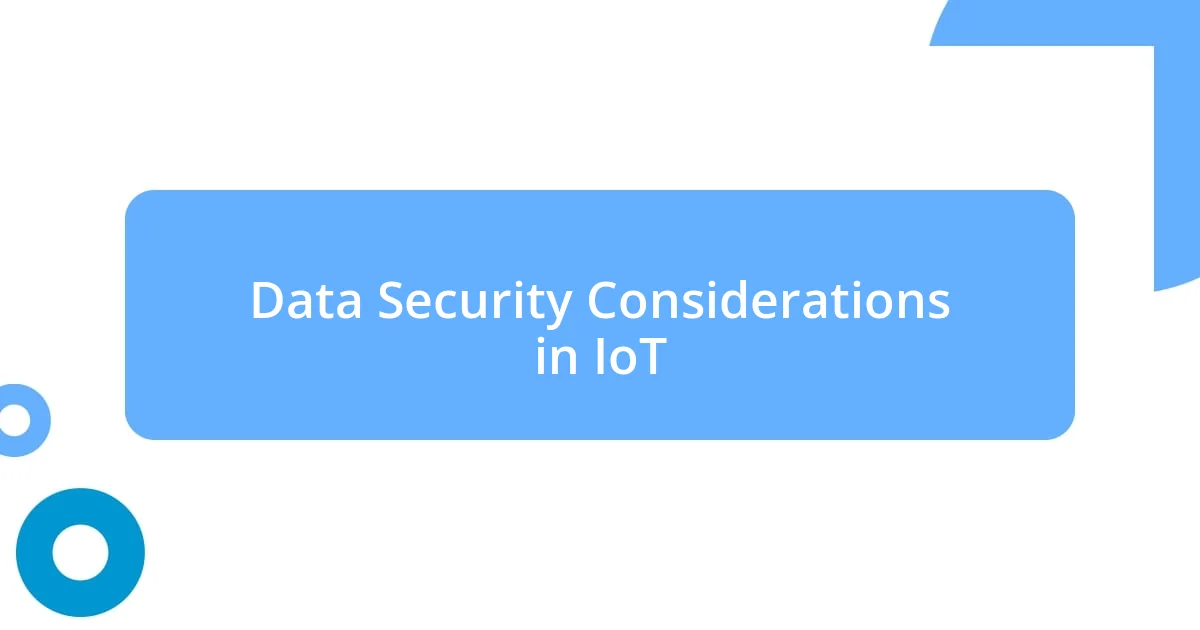
Data Security Considerations in IoT
When integrating IoT solutions, data security can’t be an afterthought; it must be front and center. From my experience, I once overlooked the need for robust security protocols, thinking our devices were safe enough. However, it didn’t take long before I faced the reality of a security breach, which led to a stressful scramble to regain control of our data. It raised an important question: How prepared are we to respond to potential threats?
Having learned my lesson, I now advocate for implementing strict authentication measures for all IoT devices. In one project, we introduced multi-factor authentication, which significantly fortified our system’s defenses. I remember the initial resistance from the team, as they thought it would slow things down. But I saw that security doesn’t have to hinder productivity—instead, it enhances trust in our systems. Isn’t it comforting to know that extra layers of security can lead to a smoother operation overall?
Moreover, regular security audits became a game changer for us. I vividly recall conducting our first audit, which unveiled vulnerabilities I hadn’t considered. It made me realize how essential it is to reassess our security posture regularly. By continually revisiting our security measures, we not only protected our data but created a culture of awareness that kept everyone engaged. Are you taking the time to ask tough questions about your IoT security, or are you assuming everything is fine?
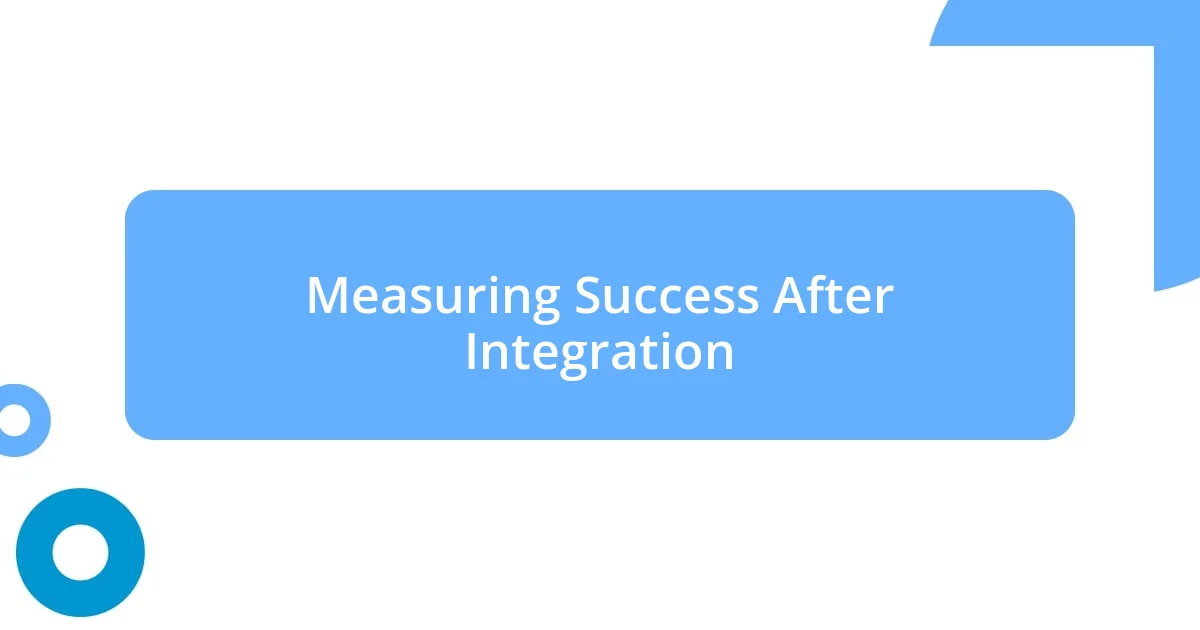
Measuring Success After Integration
Measuring success after integrating IoT solutions requires outlining clear metrics from the outset. One memorable project taught me the importance of KPIs—key performance indicators—tailored specifically to our goals. I distinctly remember how we tracked everything from operational efficiency to customer satisfaction, and those insights turned into our roadmap for continuous improvement. Are you keeping score on what’s working and what isn’t?
I found that success isn’t solely about numbers; it’s also about the impact on your team. After integrating IoT solutions, I observed a noticeable boost in collaboration among my colleagues who felt empowered by real-time data. Their enthusiasm was palpable, and that collective energy made me realize that successful integration creates a culture of innovation. How engaged is your team in the process—is it a shared victory or merely a series of tasks?
Lastly, the feedback loop is crucial for measuring long-term success. Early on, I implemented regular check-ins to gather insights from users, and I’m glad I did. In one instance, a team member suggested a minor tweak that resulted in a significant increase in device performance. I learned that listening to those on the ground can yield invaluable insights and foster an environment where everyone feels invested in the outcome. Are you actively seeking feedback to refine your IoT strategies, or are you leaving it to chance?
